University Essay: Blockchain's Role in Preventing Data Tampering
VerifiedAdded on 2023/04/20
|8
|1999
|95
Essay
AI Summary
This essay delves into the potential of blockchain technology to prevent data tampering, exploring its underlying principles, including cryptographic hashes, distributed ledgers, and smart contracts. The essay discusses the formation of blockchain, its components (digital keys, miners, smart contracts, and distributed ledger technology), and consensus mechanisms. It analyzes the societal impacts of blockchain, specifically its role in data protection and security. The discussion covers real-world applications, such as supply chain management and copyright protection, while also addressing challenges such as scalability, legal issues, efficiency, security concerns, complexity, initial setup costs, and integration with legacy systems. The essay concludes that blockchain implementation can enhance data security and prevent tampering through cryptographic methods, emphasizing the technology's potential to revolutionize various sectors.

Running head: BLOCKCHAIN
BLOCKCHAIN
Name of student
Name of university
Author’s note:
BLOCKCHAIN
Name of student
Name of university
Author’s note:
Paraphrase This Document
Need a fresh take? Get an instant paraphrase of this document with our AI Paraphraser
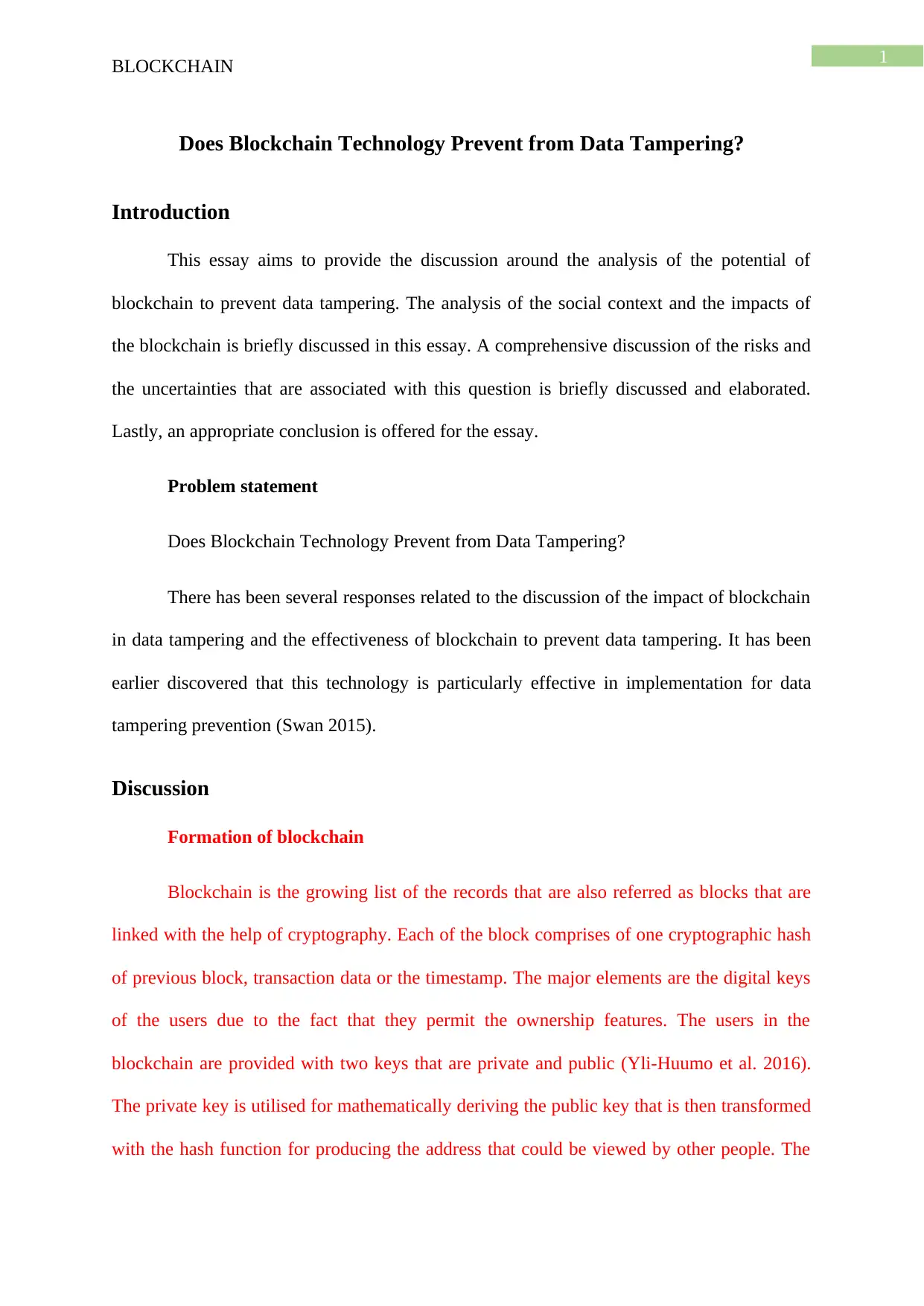
1
BLOCKCHAIN
Does Blockchain Technology Prevent from Data Tampering?
Introduction
This essay aims to provide the discussion around the analysis of the potential of
blockchain to prevent data tampering. The analysis of the social context and the impacts of
the blockchain is briefly discussed in this essay. A comprehensive discussion of the risks and
the uncertainties that are associated with this question is briefly discussed and elaborated.
Lastly, an appropriate conclusion is offered for the essay.
Problem statement
Does Blockchain Technology Prevent from Data Tampering?
There has been several responses related to the discussion of the impact of blockchain
in data tampering and the effectiveness of blockchain to prevent data tampering. It has been
earlier discovered that this technology is particularly effective in implementation for data
tampering prevention (Swan 2015).
Discussion
Formation of blockchain
Blockchain is the growing list of the records that are also referred as blocks that are
linked with the help of cryptography. Each of the block comprises of one cryptographic hash
of previous block, transaction data or the timestamp. The major elements are the digital keys
of the users due to the fact that they permit the ownership features. The users in the
blockchain are provided with two keys that are private and public (Yli-Huumo et al. 2016).
The private key is utilised for mathematically deriving the public key that is then transformed
with the hash function for producing the address that could be viewed by other people. The
BLOCKCHAIN
Does Blockchain Technology Prevent from Data Tampering?
Introduction
This essay aims to provide the discussion around the analysis of the potential of
blockchain to prevent data tampering. The analysis of the social context and the impacts of
the blockchain is briefly discussed in this essay. A comprehensive discussion of the risks and
the uncertainties that are associated with this question is briefly discussed and elaborated.
Lastly, an appropriate conclusion is offered for the essay.
Problem statement
Does Blockchain Technology Prevent from Data Tampering?
There has been several responses related to the discussion of the impact of blockchain
in data tampering and the effectiveness of blockchain to prevent data tampering. It has been
earlier discovered that this technology is particularly effective in implementation for data
tampering prevention (Swan 2015).
Discussion
Formation of blockchain
Blockchain is the growing list of the records that are also referred as blocks that are
linked with the help of cryptography. Each of the block comprises of one cryptographic hash
of previous block, transaction data or the timestamp. The major elements are the digital keys
of the users due to the fact that they permit the ownership features. The users in the
blockchain are provided with two keys that are private and public (Yli-Huumo et al. 2016).
The private key is utilised for mathematically deriving the public key that is then transformed
with the hash function for producing the address that could be viewed by other people. The
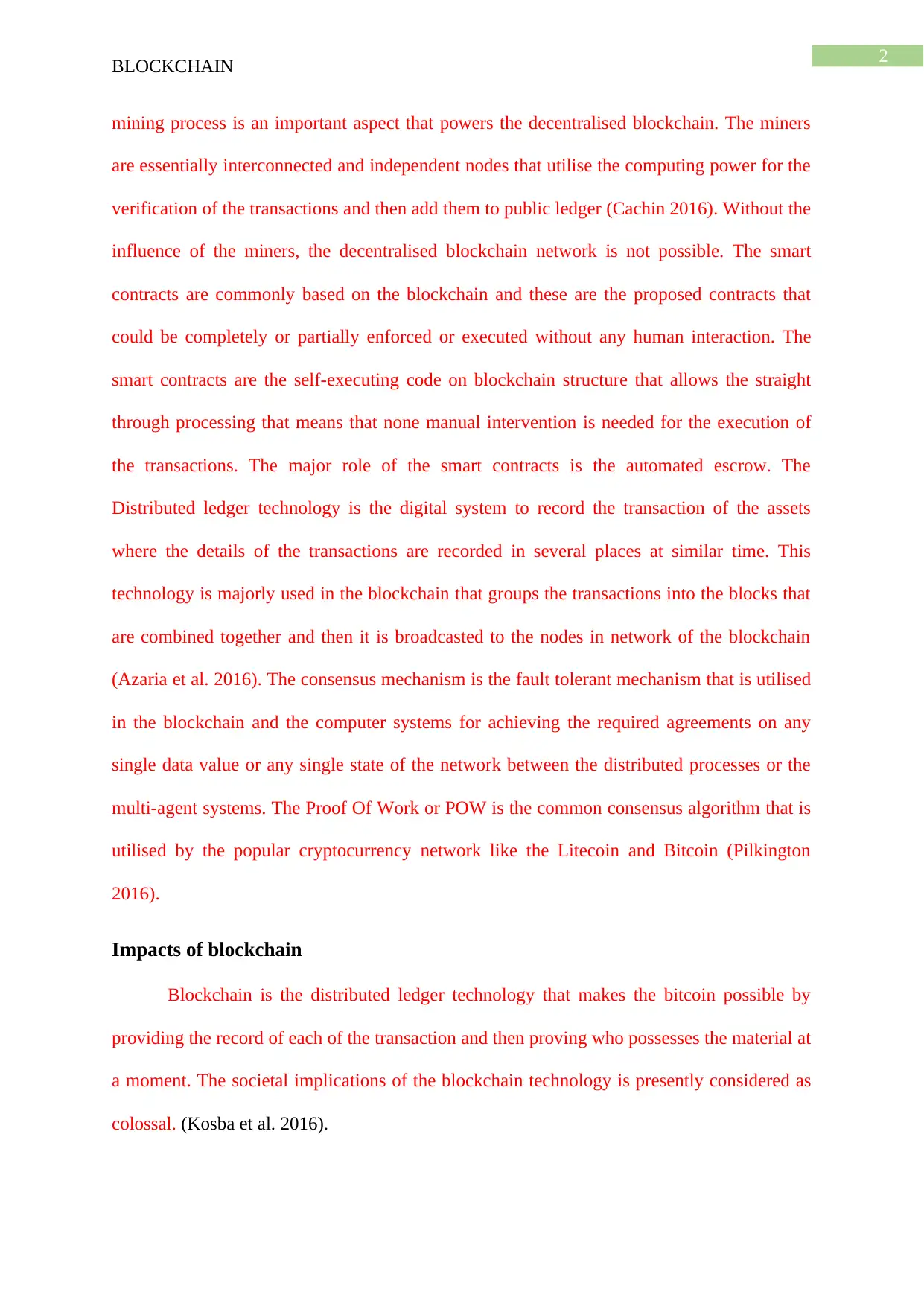
2
BLOCKCHAIN
mining process is an important aspect that powers the decentralised blockchain. The miners
are essentially interconnected and independent nodes that utilise the computing power for the
verification of the transactions and then add them to public ledger (Cachin 2016). Without the
influence of the miners, the decentralised blockchain network is not possible. The smart
contracts are commonly based on the blockchain and these are the proposed contracts that
could be completely or partially enforced or executed without any human interaction. The
smart contracts are the self-executing code on blockchain structure that allows the straight
through processing that means that none manual intervention is needed for the execution of
the transactions. The major role of the smart contracts is the automated escrow. The
Distributed ledger technology is the digital system to record the transaction of the assets
where the details of the transactions are recorded in several places at similar time. This
technology is majorly used in the blockchain that groups the transactions into the blocks that
are combined together and then it is broadcasted to the nodes in network of the blockchain
(Azaria et al. 2016). The consensus mechanism is the fault tolerant mechanism that is utilised
in the blockchain and the computer systems for achieving the required agreements on any
single data value or any single state of the network between the distributed processes or the
multi-agent systems. The Proof Of Work or POW is the common consensus algorithm that is
utilised by the popular cryptocurrency network like the Litecoin and Bitcoin (Pilkington
2016).
Impacts of blockchain
Blockchain is the distributed ledger technology that makes the bitcoin possible by
providing the record of each of the transaction and then proving who possesses the material at
a moment. The societal implications of the blockchain technology is presently considered as
colossal. (Kosba et al. 2016).
BLOCKCHAIN
mining process is an important aspect that powers the decentralised blockchain. The miners
are essentially interconnected and independent nodes that utilise the computing power for the
verification of the transactions and then add them to public ledger (Cachin 2016). Without the
influence of the miners, the decentralised blockchain network is not possible. The smart
contracts are commonly based on the blockchain and these are the proposed contracts that
could be completely or partially enforced or executed without any human interaction. The
smart contracts are the self-executing code on blockchain structure that allows the straight
through processing that means that none manual intervention is needed for the execution of
the transactions. The major role of the smart contracts is the automated escrow. The
Distributed ledger technology is the digital system to record the transaction of the assets
where the details of the transactions are recorded in several places at similar time. This
technology is majorly used in the blockchain that groups the transactions into the blocks that
are combined together and then it is broadcasted to the nodes in network of the blockchain
(Azaria et al. 2016). The consensus mechanism is the fault tolerant mechanism that is utilised
in the blockchain and the computer systems for achieving the required agreements on any
single data value or any single state of the network between the distributed processes or the
multi-agent systems. The Proof Of Work or POW is the common consensus algorithm that is
utilised by the popular cryptocurrency network like the Litecoin and Bitcoin (Pilkington
2016).
Impacts of blockchain
Blockchain is the distributed ledger technology that makes the bitcoin possible by
providing the record of each of the transaction and then proving who possesses the material at
a moment. The societal implications of the blockchain technology is presently considered as
colossal. (Kosba et al. 2016).
⊘ This is a preview!⊘
Do you want full access?
Subscribe today to unlock all pages.

Trusted by 1+ million students worldwide
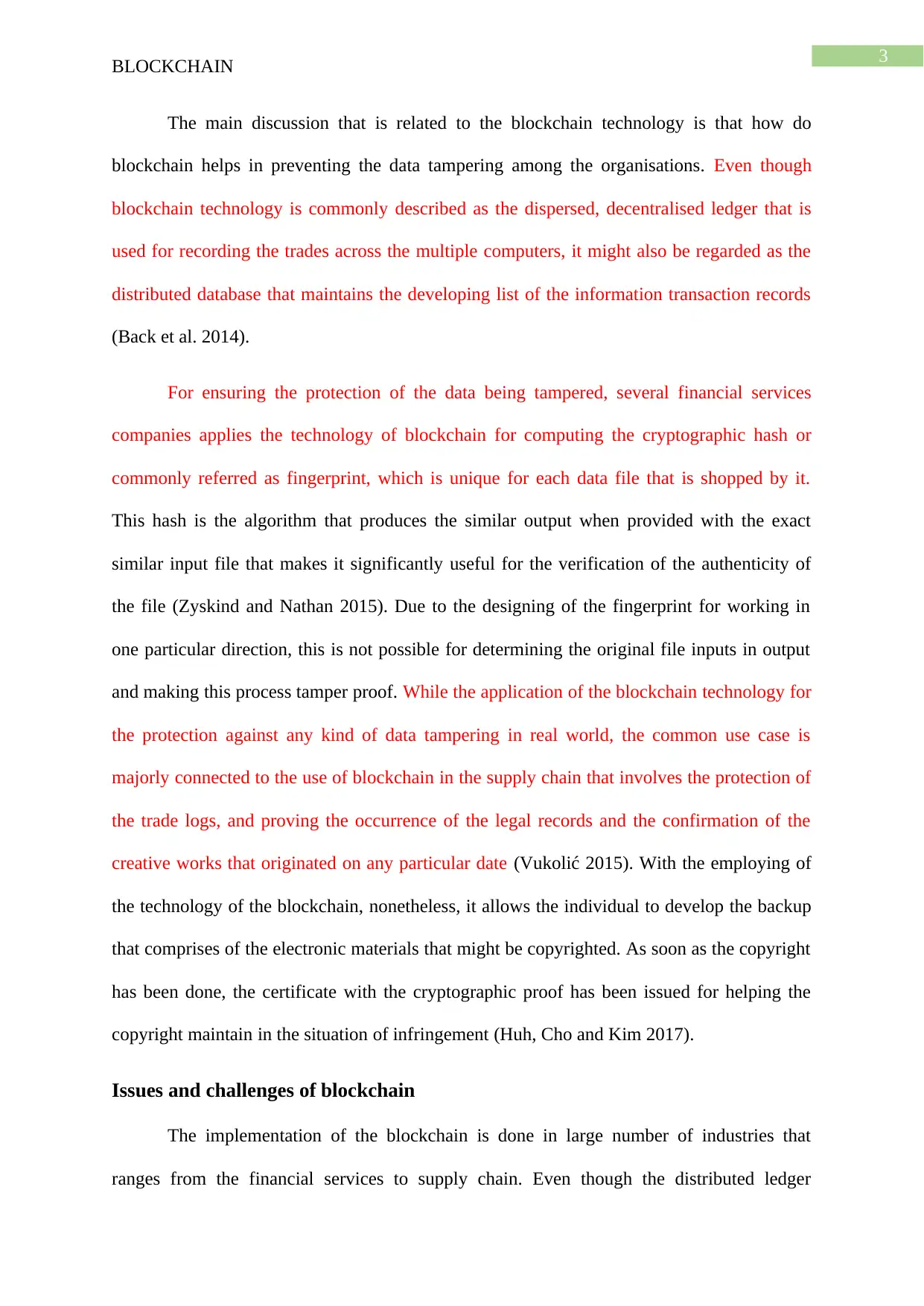
3
BLOCKCHAIN
The main discussion that is related to the blockchain technology is that how do
blockchain helps in preventing the data tampering among the organisations. Even though
blockchain technology is commonly described as the dispersed, decentralised ledger that is
used for recording the trades across the multiple computers, it might also be regarded as the
distributed database that maintains the developing list of the information transaction records
(Back et al. 2014).
For ensuring the protection of the data being tampered, several financial services
companies applies the technology of blockchain for computing the cryptographic hash or
commonly referred as fingerprint, which is unique for each data file that is shopped by it.
This hash is the algorithm that produces the similar output when provided with the exact
similar input file that makes it significantly useful for the verification of the authenticity of
the file (Zyskind and Nathan 2015). Due to the designing of the fingerprint for working in
one particular direction, this is not possible for determining the original file inputs in output
and making this process tamper proof. While the application of the blockchain technology for
the protection against any kind of data tampering in real world, the common use case is
majorly connected to the use of blockchain in the supply chain that involves the protection of
the trade logs, and proving the occurrence of the legal records and the confirmation of the
creative works that originated on any particular date (Vukolić 2015). With the employing of
the technology of the blockchain, nonetheless, it allows the individual to develop the backup
that comprises of the electronic materials that might be copyrighted. As soon as the copyright
has been done, the certificate with the cryptographic proof has been issued for helping the
copyright maintain in the situation of infringement (Huh, Cho and Kim 2017).
Issues and challenges of blockchain
The implementation of the blockchain is done in large number of industries that
ranges from the financial services to supply chain. Even though the distributed ledger
BLOCKCHAIN
The main discussion that is related to the blockchain technology is that how do
blockchain helps in preventing the data tampering among the organisations. Even though
blockchain technology is commonly described as the dispersed, decentralised ledger that is
used for recording the trades across the multiple computers, it might also be regarded as the
distributed database that maintains the developing list of the information transaction records
(Back et al. 2014).
For ensuring the protection of the data being tampered, several financial services
companies applies the technology of blockchain for computing the cryptographic hash or
commonly referred as fingerprint, which is unique for each data file that is shopped by it.
This hash is the algorithm that produces the similar output when provided with the exact
similar input file that makes it significantly useful for the verification of the authenticity of
the file (Zyskind and Nathan 2015). Due to the designing of the fingerprint for working in
one particular direction, this is not possible for determining the original file inputs in output
and making this process tamper proof. While the application of the blockchain technology for
the protection against any kind of data tampering in real world, the common use case is
majorly connected to the use of blockchain in the supply chain that involves the protection of
the trade logs, and proving the occurrence of the legal records and the confirmation of the
creative works that originated on any particular date (Vukolić 2015). With the employing of
the technology of the blockchain, nonetheless, it allows the individual to develop the backup
that comprises of the electronic materials that might be copyrighted. As soon as the copyright
has been done, the certificate with the cryptographic proof has been issued for helping the
copyright maintain in the situation of infringement (Huh, Cho and Kim 2017).
Issues and challenges of blockchain
The implementation of the blockchain is done in large number of industries that
ranges from the financial services to supply chain. Even though the distributed ledger
Paraphrase This Document
Need a fresh take? Get an instant paraphrase of this document with our AI Paraphraser
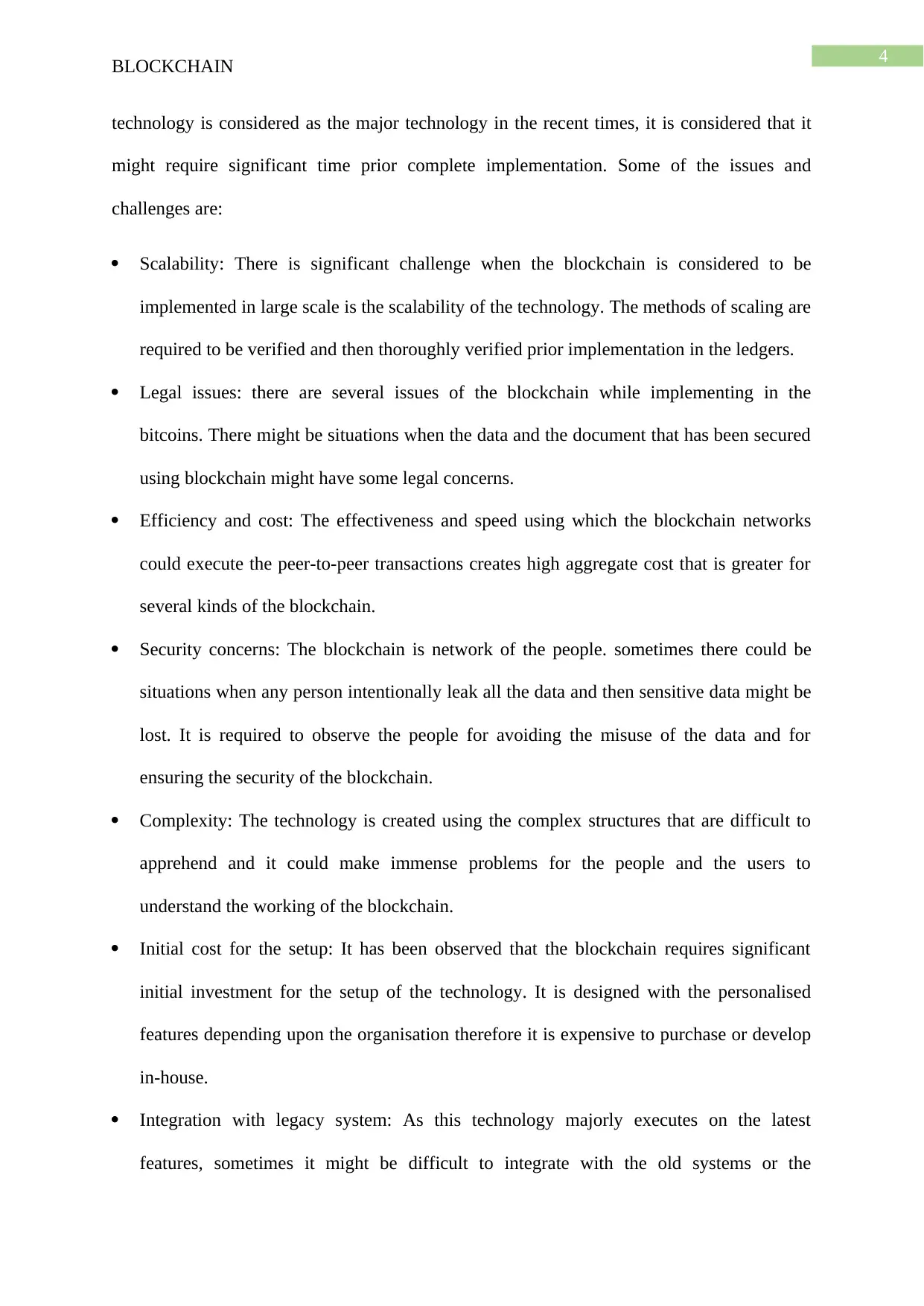
4
BLOCKCHAIN
technology is considered as the major technology in the recent times, it is considered that it
might require significant time prior complete implementation. Some of the issues and
challenges are:
Scalability: There is significant challenge when the blockchain is considered to be
implemented in large scale is the scalability of the technology. The methods of scaling are
required to be verified and then thoroughly verified prior implementation in the ledgers.
Legal issues: there are several issues of the blockchain while implementing in the
bitcoins. There might be situations when the data and the document that has been secured
using blockchain might have some legal concerns.
Efficiency and cost: The effectiveness and speed using which the blockchain networks
could execute the peer-to-peer transactions creates high aggregate cost that is greater for
several kinds of the blockchain.
Security concerns: The blockchain is network of the people. sometimes there could be
situations when any person intentionally leak all the data and then sensitive data might be
lost. It is required to observe the people for avoiding the misuse of the data and for
ensuring the security of the blockchain.
Complexity: The technology is created using the complex structures that are difficult to
apprehend and it could make immense problems for the people and the users to
understand the working of the blockchain.
Initial cost for the setup: It has been observed that the blockchain requires significant
initial investment for the setup of the technology. It is designed with the personalised
features depending upon the organisation therefore it is expensive to purchase or develop
in-house.
Integration with legacy system: As this technology majorly executes on the latest
features, sometimes it might be difficult to integrate with the old systems or the
BLOCKCHAIN
technology is considered as the major technology in the recent times, it is considered that it
might require significant time prior complete implementation. Some of the issues and
challenges are:
Scalability: There is significant challenge when the blockchain is considered to be
implemented in large scale is the scalability of the technology. The methods of scaling are
required to be verified and then thoroughly verified prior implementation in the ledgers.
Legal issues: there are several issues of the blockchain while implementing in the
bitcoins. There might be situations when the data and the document that has been secured
using blockchain might have some legal concerns.
Efficiency and cost: The effectiveness and speed using which the blockchain networks
could execute the peer-to-peer transactions creates high aggregate cost that is greater for
several kinds of the blockchain.
Security concerns: The blockchain is network of the people. sometimes there could be
situations when any person intentionally leak all the data and then sensitive data might be
lost. It is required to observe the people for avoiding the misuse of the data and for
ensuring the security of the blockchain.
Complexity: The technology is created using the complex structures that are difficult to
apprehend and it could make immense problems for the people and the users to
understand the working of the blockchain.
Initial cost for the setup: It has been observed that the blockchain requires significant
initial investment for the setup of the technology. It is designed with the personalised
features depending upon the organisation therefore it is expensive to purchase or develop
in-house.
Integration with legacy system: As this technology majorly executes on the latest
features, sometimes it might be difficult to integrate with the old systems or the
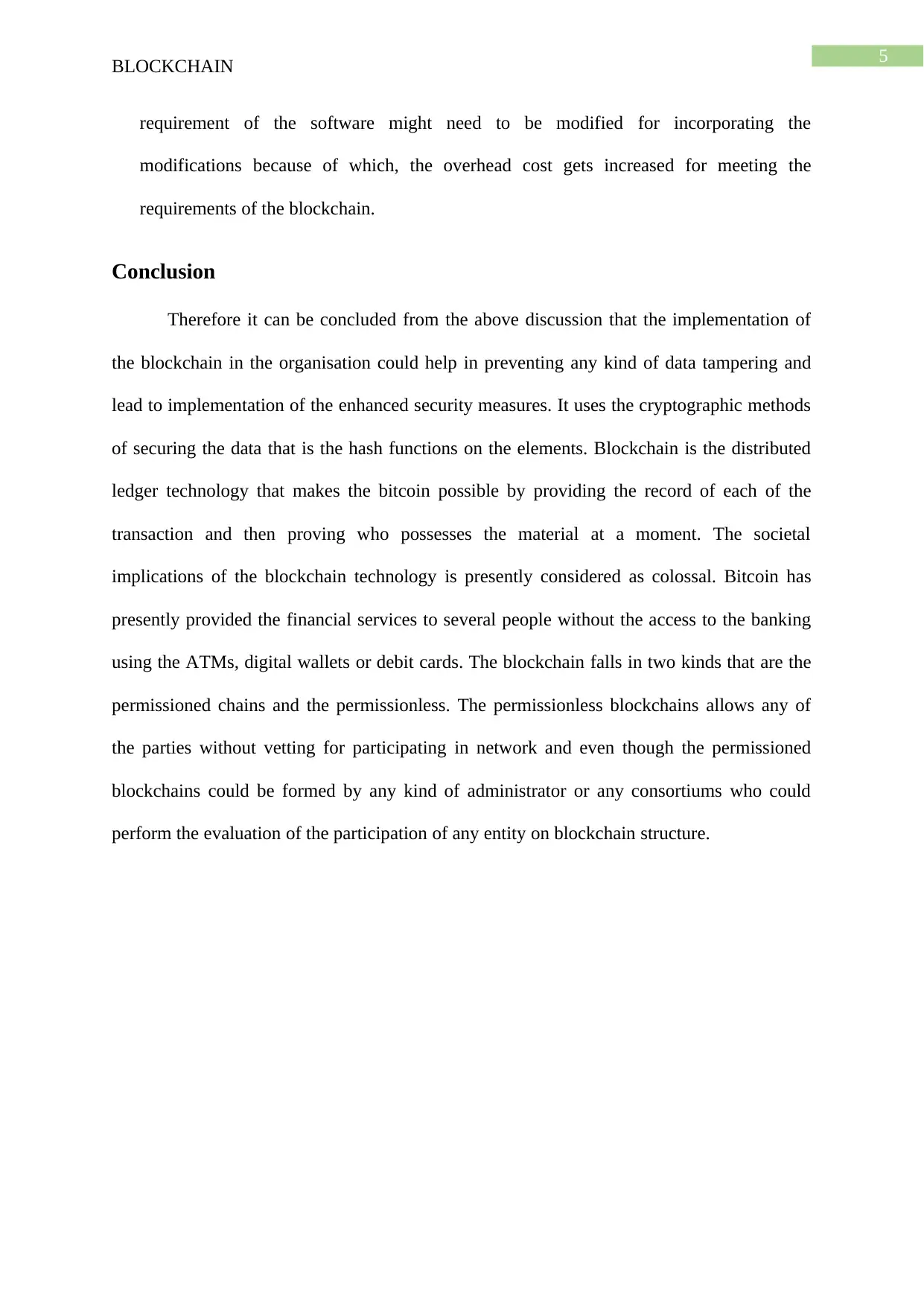
5
BLOCKCHAIN
requirement of the software might need to be modified for incorporating the
modifications because of which, the overhead cost gets increased for meeting the
requirements of the blockchain.
Conclusion
Therefore it can be concluded from the above discussion that the implementation of
the blockchain in the organisation could help in preventing any kind of data tampering and
lead to implementation of the enhanced security measures. It uses the cryptographic methods
of securing the data that is the hash functions on the elements. Blockchain is the distributed
ledger technology that makes the bitcoin possible by providing the record of each of the
transaction and then proving who possesses the material at a moment. The societal
implications of the blockchain technology is presently considered as colossal. Bitcoin has
presently provided the financial services to several people without the access to the banking
using the ATMs, digital wallets or debit cards. The blockchain falls in two kinds that are the
permissioned chains and the permissionless. The permissionless blockchains allows any of
the parties without vetting for participating in network and even though the permissioned
blockchains could be formed by any kind of administrator or any consortiums who could
perform the evaluation of the participation of any entity on blockchain structure.
BLOCKCHAIN
requirement of the software might need to be modified for incorporating the
modifications because of which, the overhead cost gets increased for meeting the
requirements of the blockchain.
Conclusion
Therefore it can be concluded from the above discussion that the implementation of
the blockchain in the organisation could help in preventing any kind of data tampering and
lead to implementation of the enhanced security measures. It uses the cryptographic methods
of securing the data that is the hash functions on the elements. Blockchain is the distributed
ledger technology that makes the bitcoin possible by providing the record of each of the
transaction and then proving who possesses the material at a moment. The societal
implications of the blockchain technology is presently considered as colossal. Bitcoin has
presently provided the financial services to several people without the access to the banking
using the ATMs, digital wallets or debit cards. The blockchain falls in two kinds that are the
permissioned chains and the permissionless. The permissionless blockchains allows any of
the parties without vetting for participating in network and even though the permissioned
blockchains could be formed by any kind of administrator or any consortiums who could
perform the evaluation of the participation of any entity on blockchain structure.
⊘ This is a preview!⊘
Do you want full access?
Subscribe today to unlock all pages.

Trusted by 1+ million students worldwide
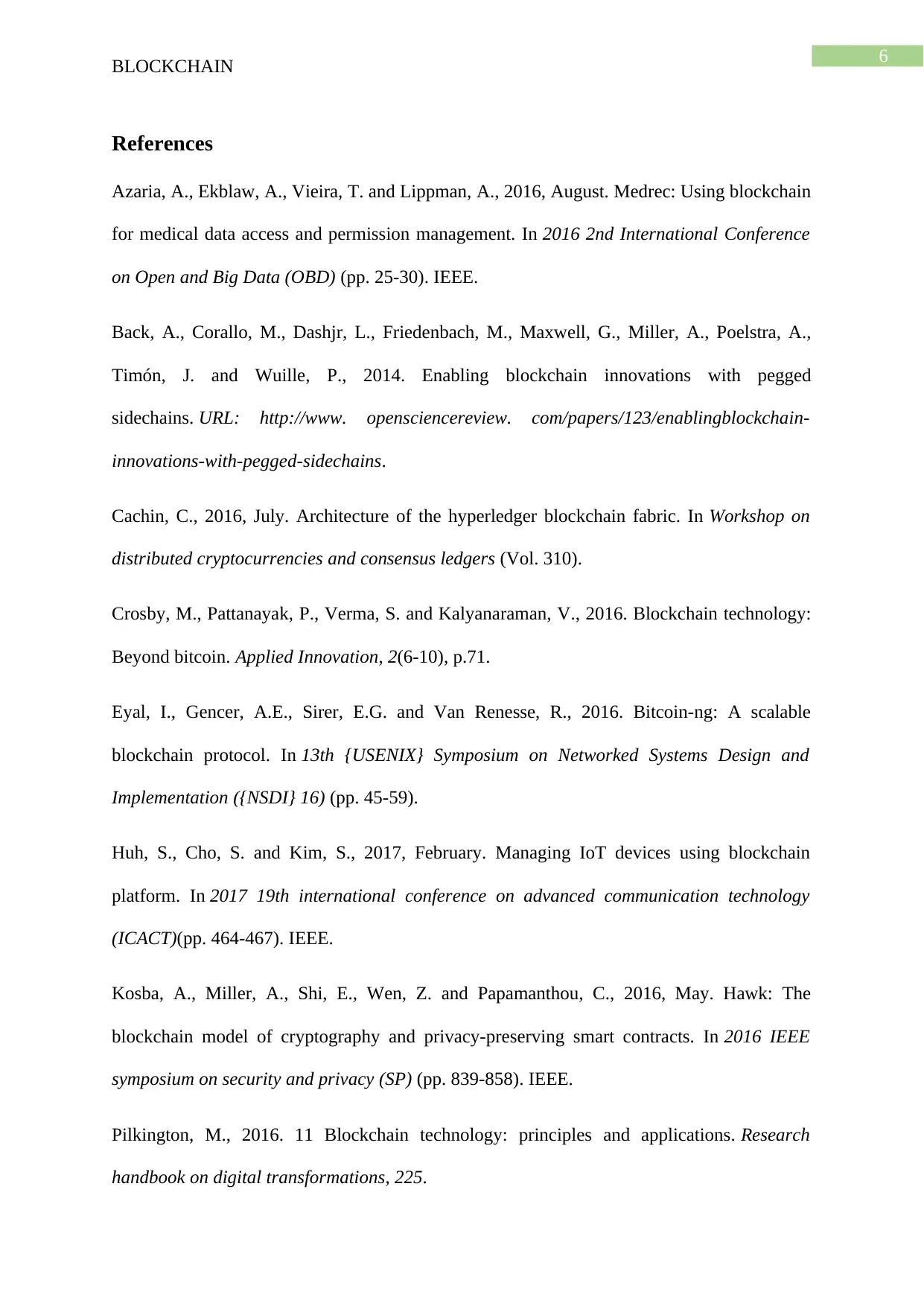
6
BLOCKCHAIN
References
Azaria, A., Ekblaw, A., Vieira, T. and Lippman, A., 2016, August. Medrec: Using blockchain
for medical data access and permission management. In 2016 2nd International Conference
on Open and Big Data (OBD) (pp. 25-30). IEEE.
Back, A., Corallo, M., Dashjr, L., Friedenbach, M., Maxwell, G., Miller, A., Poelstra, A.,
Timón, J. and Wuille, P., 2014. Enabling blockchain innovations with pegged
sidechains. URL: http://www. opensciencereview. com/papers/123/enablingblockchain-
innovations-with-pegged-sidechains.
Cachin, C., 2016, July. Architecture of the hyperledger blockchain fabric. In Workshop on
distributed cryptocurrencies and consensus ledgers (Vol. 310).
Crosby, M., Pattanayak, P., Verma, S. and Kalyanaraman, V., 2016. Blockchain technology:
Beyond bitcoin. Applied Innovation, 2(6-10), p.71.
Eyal, I., Gencer, A.E., Sirer, E.G. and Van Renesse, R., 2016. Bitcoin-ng: A scalable
blockchain protocol. In 13th {USENIX} Symposium on Networked Systems Design and
Implementation ({NSDI} 16) (pp. 45-59).
Huh, S., Cho, S. and Kim, S., 2017, February. Managing IoT devices using blockchain
platform. In 2017 19th international conference on advanced communication technology
(ICACT)(pp. 464-467). IEEE.
Kosba, A., Miller, A., Shi, E., Wen, Z. and Papamanthou, C., 2016, May. Hawk: The
blockchain model of cryptography and privacy-preserving smart contracts. In 2016 IEEE
symposium on security and privacy (SP) (pp. 839-858). IEEE.
Pilkington, M., 2016. 11 Blockchain technology: principles and applications. Research
handbook on digital transformations, 225.
BLOCKCHAIN
References
Azaria, A., Ekblaw, A., Vieira, T. and Lippman, A., 2016, August. Medrec: Using blockchain
for medical data access and permission management. In 2016 2nd International Conference
on Open and Big Data (OBD) (pp. 25-30). IEEE.
Back, A., Corallo, M., Dashjr, L., Friedenbach, M., Maxwell, G., Miller, A., Poelstra, A.,
Timón, J. and Wuille, P., 2014. Enabling blockchain innovations with pegged
sidechains. URL: http://www. opensciencereview. com/papers/123/enablingblockchain-
innovations-with-pegged-sidechains.
Cachin, C., 2016, July. Architecture of the hyperledger blockchain fabric. In Workshop on
distributed cryptocurrencies and consensus ledgers (Vol. 310).
Crosby, M., Pattanayak, P., Verma, S. and Kalyanaraman, V., 2016. Blockchain technology:
Beyond bitcoin. Applied Innovation, 2(6-10), p.71.
Eyal, I., Gencer, A.E., Sirer, E.G. and Van Renesse, R., 2016. Bitcoin-ng: A scalable
blockchain protocol. In 13th {USENIX} Symposium on Networked Systems Design and
Implementation ({NSDI} 16) (pp. 45-59).
Huh, S., Cho, S. and Kim, S., 2017, February. Managing IoT devices using blockchain
platform. In 2017 19th international conference on advanced communication technology
(ICACT)(pp. 464-467). IEEE.
Kosba, A., Miller, A., Shi, E., Wen, Z. and Papamanthou, C., 2016, May. Hawk: The
blockchain model of cryptography and privacy-preserving smart contracts. In 2016 IEEE
symposium on security and privacy (SP) (pp. 839-858). IEEE.
Pilkington, M., 2016. 11 Blockchain technology: principles and applications. Research
handbook on digital transformations, 225.
Paraphrase This Document
Need a fresh take? Get an instant paraphrase of this document with our AI Paraphraser
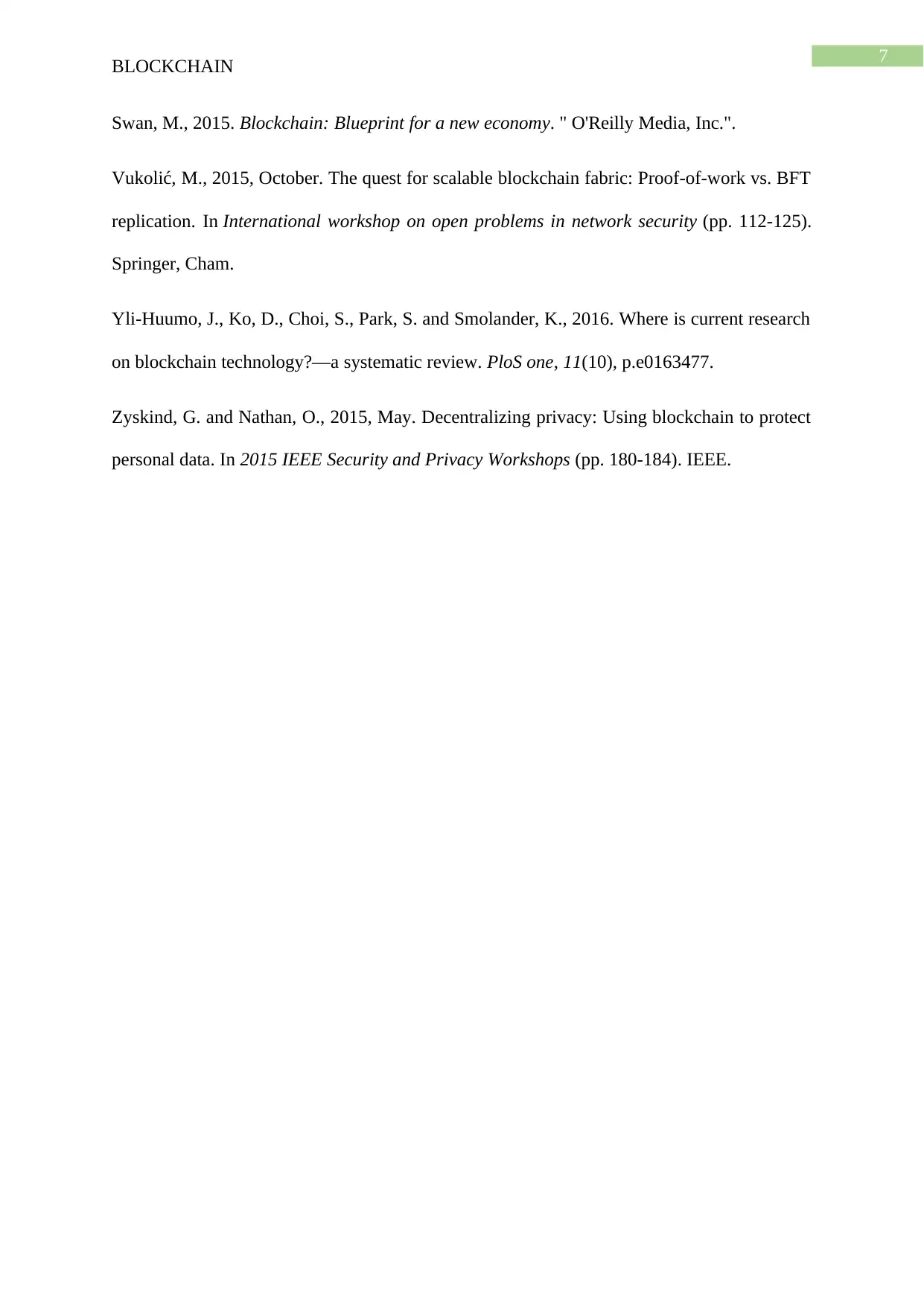
7
BLOCKCHAIN
Swan, M., 2015. Blockchain: Blueprint for a new economy. " O'Reilly Media, Inc.".
Vukolić, M., 2015, October. The quest for scalable blockchain fabric: Proof-of-work vs. BFT
replication. In International workshop on open problems in network security (pp. 112-125).
Springer, Cham.
Yli-Huumo, J., Ko, D., Choi, S., Park, S. and Smolander, K., 2016. Where is current research
on blockchain technology?—a systematic review. PloS one, 11(10), p.e0163477.
Zyskind, G. and Nathan, O., 2015, May. Decentralizing privacy: Using blockchain to protect
personal data. In 2015 IEEE Security and Privacy Workshops (pp. 180-184). IEEE.
BLOCKCHAIN
Swan, M., 2015. Blockchain: Blueprint for a new economy. " O'Reilly Media, Inc.".
Vukolić, M., 2015, October. The quest for scalable blockchain fabric: Proof-of-work vs. BFT
replication. In International workshop on open problems in network security (pp. 112-125).
Springer, Cham.
Yli-Huumo, J., Ko, D., Choi, S., Park, S. and Smolander, K., 2016. Where is current research
on blockchain technology?—a systematic review. PloS one, 11(10), p.e0163477.
Zyskind, G. and Nathan, O., 2015, May. Decentralizing privacy: Using blockchain to protect
personal data. In 2015 IEEE Security and Privacy Workshops (pp. 180-184). IEEE.
1 out of 8
Related Documents
Your All-in-One AI-Powered Toolkit for Academic Success.
+13062052269
info@desklib.com
Available 24*7 on WhatsApp / Email
![[object Object]](/_next/static/media/star-bottom.7253800d.svg)
Unlock your academic potential
Copyright © 2020–2025 A2Z Services. All Rights Reserved. Developed and managed by ZUCOL.




